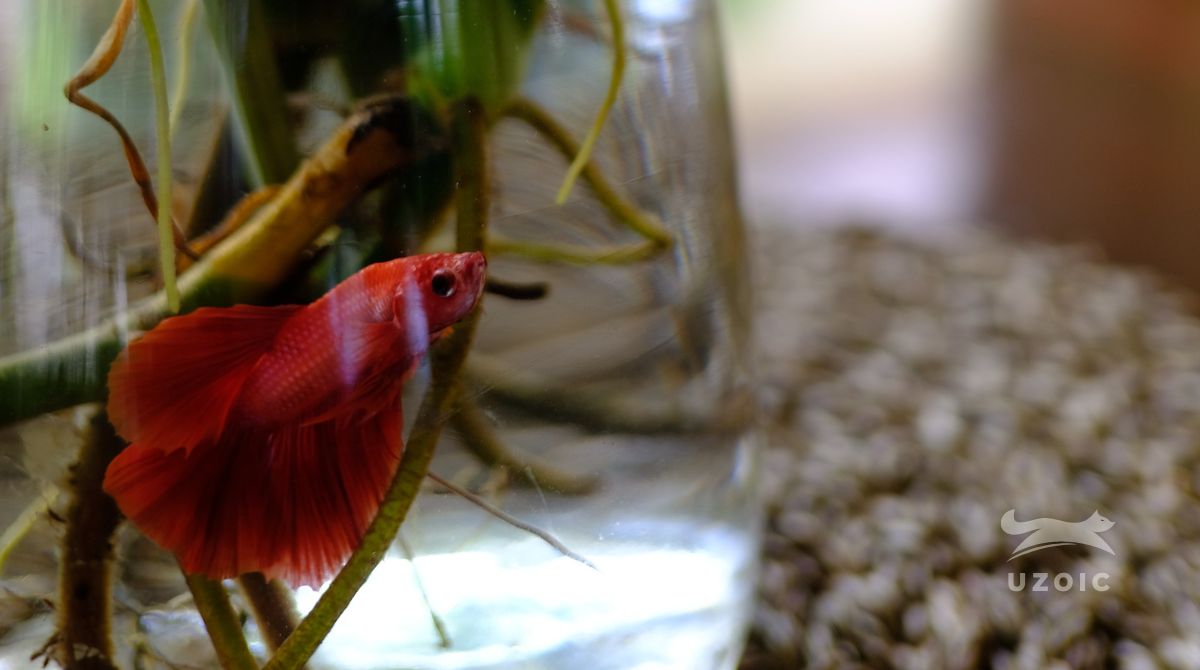If you have a Betta fish with clamped fins, you may be wondering what is wrong with your fish.
Bettas are beautiful fish that can add life to any aquarium, but they require some special care. Clamped fins can be caused by a number of things, from poor water quality to stress.
One of the most important things you can do for your Betta is maintaining clean water.
Bettas are very sensitive to changes in their environment, and even small amounts of ammonia or nitrites can cause stress. This can lead to a number of health problems, including clamped fins.
So, test your water regularly using any water test kit and do weekly water changes to keep your Betta’s home clean and stress-free.
Another important thing to remember is that Bettas are tropical fish and prefer warm water.
If the water in your tank is too cold, it can cause your Betta to go into shock, which can lead to clamped fins. Be sure to use a heater to maintain a consistent water temperature in your tank.
If you think your Betta’s fins are clamped due to stress, there are a few things you can do to help him feel more comfortable.
First, try adding some plants or other hiding places to your tank. This will give your Betta somewhere to go if he feels overwhelmed or needs a break from the action.
You can also try changing the lighting in your tank to a dimmer setting. This will help reduce stress and make your Betta feel more at ease.
Finally, remember that Bettas are social creatures and need interaction with their owners. So be sure to spend time each day talking to your Betta and letting him know that he is loved.
This will help reduce stress and make him feel more comfortable in his home.
Table of Contents
Why Is My Betta Not Opening His Fins?
Your Betta is not opening fins because it is stressed or has an infection such as fin melt.
There can be many reasons why your Betta may not be opening his fins, but some of the most likely culprits are stress and poor water quality.
Stress is often a result of environmental factors, such as too much tank traffic or a lack of hiding places for the fish.
When a betta feels stressed, he may simply close his fins as a way to conserve energy or protect himself from potential threats.
In addition, low water quality can also cause hindrance in fin movement.
For example, if your Betta is exposed to ammonia or other harmful toxins in the water, this can lead to inflammation that prevents him from opening his fins properly.
In some cases, it may be a case of fin rot, which can cause damage and inflammation to the fish’s fins.
Moreover, a poor diet can also impact the health of your Betta’s fins, as a lack of important nutrients such as vitamins and minerals can prevent them from developing properly.
How To Care For A Betta With Clamped Fins?
The first step in caring for a betta with clamped fins is to establish the cause of the issue.
Possible causes can include poor water quality due to overstocking or a lack of cleaning, stress due to aggressive tankmates, or even injury from fighting.
To address the root cause, you may need to perform some routine maintenance tasks such as cleaning and water changes, re-sizing or moving your tankmates, or checking for wounds and treating them as necessary.
In addition, you may also want to consider adding some additional décor or vegetation to your aquarium in order to make your fish feel more comfortable and at home.
With regular care and attention, you can help ensure that your Betta’s fins remain healthy and free from damage.
Why Does My Betta Fish Have Clamped Fins?
The most common cause is poor water quality and stress. Ammonia and nitrite levels that are too high can damage the fins, making them more susceptible to fin rot or other infections.
Another possible cause is a lack of vitamins or minerals in the diet. Bettas also need plenty of clean, fresh water to stay healthy.
If the water in their tank is dirty or stagnant, it can lead to fin problems. Finally, physical trauma can sometimes cause clamped fins.
Check if your Betta has been nipped by another fish or has gotten caught in some plants, as it could damage the fins and make them more likely to become stuck together.
Also, if you have recently made any changes to Betta’s environment, it could have resulted in higher stress levels causing the fins to be clamped.
So ask yourself, have you added another fish or plant to the tank recently? If yes, it has probably not gone down well with your Betta.
Try to remove any new additions and see if the fins go back to normal.
How Do You Treat Clamped Fins In Betta Fish?
The treatment plan starts by identifying the root causes.
Your Betta’s fins may remain stuck together (clamped) if you do not eliminate the root cause of the problem.
Let’s start with the water quality.
Water Quality Issues
Ammonia And Nitrite Water Levels
Find out the ammonia and nitrate levels in the tank using API Water Test Kit.
Then proceed to fix the problem by changing the water and adding a Betta-specific ammonia remover such as Betta Basics to your tank.
This should help lower ammonia and nitrite levels in the water, making it safer for your Betta.
Water Temperature
The next step is to check the water temperature in the tank. The ideal water temperature for a Betta is between 75 and 80 degrees Fahrenheit (23-27 Celsius) [Source: Adelphi University].
Use an aquarium thermometer to check the temperature of the water. If it is too cold, then you need to use an aquarium heater to raise the temperature of the water.
Diet
A poor diet can also lead to clamped fins. Bettas require a diet that is high in protein and low in carbohydrates.
A good diet for a Betta should consist of live food, such as brine shrimp, bloodworms, and daphnia. You can also give your Betta frozen or freeze-dried versions of these foods.
In addition, you should also feed your Betta a high-quality pellet food. Be sure to read the ingredients on the packaging to ensure that the food you are giving your Betta is of good quality.
If you follow these steps, you should be able to eliminate the root causes of your Betta’s clamped fins.
Once the root causes have been eliminated, you can then start to treat the fins themselves.
Stress
One of the most common causes of clamped fins is stress.
There are many different ways to reduce stress in a Betta, such as providing him with hiding places, reducing tank traffic, and changing the lighting in the tank to a dimmer setting.
You can also try adding some live plants to the tank, as they will help to create a more natural environment for the Betta.
In addition, you should also end each day by talking to your Betta and letting him know that he is loved.
This will help reduce stress and make him feel more comfortable in his home.
Also, consider what changes you have made to its environment that induced the stress in the first place.
Betta’s are very sensitive to changes, and even something as small as a new decoration in the tank can cause stress.
If you have made any changes to the tank, such as adding new fish or changing the water, try to revert to the old setup and see if that helps.
If your Betta is still stressed, you can try using a product like StressGuard to help reduce stress and promote healing.
It contains a calming agent, detoxifier, and ammonia reducer. By reducing stress, you can often help to resolve clamped fins.
Think about moving your Betta to a hospital tank that is heated and has plenty of plants to hide and add Indian Almond Leaves and StressGuard to reduce the stress of your Betta.
If the fins open up, then the problem is another fish in the earlier tank that caused your Betta to clamp up.
Infection
If your Betta’s fins are clamped due to an infection, you will need to treat the infection with antibiotics. Betta’s are prone to a condition called Fin Melt. It is a bacterial infection that usually occurs due to water quality issues.
The bacteria enter the open wound and eat away at the tissue. This can often lead to clamped fins, as the infection prevents the fins from healing properly.
Many Betta’s have this infection, and the major reason is water quality. In fact, your new Betta may have it because of the poor living condition at the fish keeper’s store.
They may not have changed the water as required causing the bacteria to thrive and infect the Betta.
If you think your Betta has Fin Melt, you should take him to a vet for a diagnosis. The vet will then prescribe a course of antibiotics. The most common antibiotic used to treat Fin Melt is Minocycline (Maracyn 2).
Once the infection has been treated, you can then start to focus on healing the fins themselves. Many different products on the market can help to heal damaged fins. One of the most popular products is Melafix. It contains a blend of natural oils and tea tree extract that help to promote healing.
You can also use BettaFix, which contains various ingredients that help to soothe and heal damaged fins.
Parasites
Another common cause of clamped fins is parasites. There are many different types of parasites that can infect a Betta, such as ich.
Ich attaches itself to Betta’s body, causing inflammation and irritation. You will notice white spots on your Betta. You can easily treat ich with API Ick Cure.
Once the infection has been treated and the fins have started to heal, you can then focus on preventing future infections.
Steps to prevent betta fin melt (fin rot) in the future:
- Maintain a clean and healthy environment for your Betta
- Keep water quality high and perform regular water changes
- Avoid overfeeding
- Avoid adding to the stress in Betta’s environment
If you follow these steps, you should be able to care for your Betta successfully and avoid the bacterial infections in your Betta.
Conclusion
By following these simple tips, you can help your Betta recover from clamped fins and enjoy a long, healthy life.
Bettas are amazing fish, and with the proper care, they can be a beautiful addition to any home.
But, ultimately, the best way to determine why your Betta is not opening his fins is by talking to an experienced aquarium specialist or taking him to see a vet.
Then, with the right treatment plan, you can help ensure that your Betta stays healthy and feels comfortable in his tank.
Thanks for reading our article on how to take care for your Betta with clamped fins!
You may also like:
- Is Duct Tape Safe For Fish Tanks And Aquariums?
- How Long Can Betta Fish Go Without Food?
- The Best Aquarium Glue for Rocks! How to Safely Bond Your Fish Tank Decor
- How often do I feed my Betta fish


